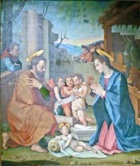

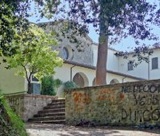
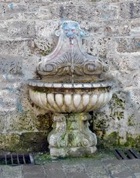
This was, in fact, the second such convent established in Terni: the convent at Santa Maria dell’ Oro had been completed in ca. 1450, but it was already proving to be too small. The Blessed Barnaba Manassei laid the foundation stone of the church here in 1474, and the inscribed date on the portal suggests that the work was completed in 1482.
The well in the cloister to the right of the church bears the date 1484, and the new convent was probably completed at about that time. Much of the original decoration of the church was carried out in the Jubilee of 1500, at the expense of Vincenzo and Ludovico Rustici.
In 1508, the friars were made responsible for a newly-formed Franciscan nunnery at San Procolo.
In 1550, the friars requested a subvention from the Commune for the consecration of the “new church”, which suggests that it was rebuilt at that time. Only the portal and the facade survive from the original structure. Three chapels were built off the left wall in the 17th century. The apse was destroyed in the earthquake of 1703; the date 1779 is painted on the inner side of the entrance to the presbytery, which suggests that it had been rebuilt by that time.
The French authorities used the convent as a military hospital in 1798-9, when the friars moved to San Valentino. They subsequently returned, but the complex was definitively suppressed in 1865, at which point a number of important works of art passed to the Pinacoteca Comunale (see below). The convent has been adapted for use as an old people’s home and is surrounded by a public park, but the church is still sometimes used for worship.
Exterior
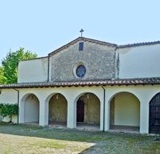
The facade of the church is protected by a portico of four arches, which contains a mortuary chapel. All of this work was carried out in 1927-32.
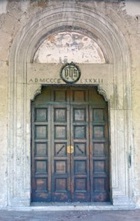
The well (1484) at the centre of the cloister to the right of the church is dated by inscription. The double arches of the cloister along the side of the church and along the east side of the cloister probably date to this period, while the single arches of the other two sides were built in the 16th century. The lunettes of the arches contain frescoes (early 18th century) of scenes from the life of St Francis.
Interior
The church has a single nave and a series of altars (late 16th century) on the right. Three chapels were built off the left wall in the 17th century. The entrance to the third, which served as a sacristy, was later closed.
Cappella della Vergine Immacolata (1602)
This chapel (the 1st on the left) belonged to the Confraternita della Concezione. The stucco altar contains a figure of the Immaculate Virgin. The panels on the walls, which have been attributed to Cesare Sermei, depict:
-
✴SS Joacchim and Anna (on the left); and
-
✴the birth of the Virgin (on the right).
Cappella dei Santi dell Ordine Francescano (1612)
A document in the archives of Terni records the decoration of this chapel by Cesare di Girolamo of Spoleto. The main frescoes depict:
-
✴the preaching of St Bernardino of Siena (on the left); and
-
✴a miracle of St Diego (on the right).
Art from the Church
The following works from Santa Maria dell Grazie are all now in the Pinacoteca Comunale.
Madonna and Child with saints (ca. 1500)

The fresco is sometimes attributed to Pier Matteo d’ Amelia, but it has been heavily repainted. It depicts the Madonna and Child with SS Francis and Bernardino of Siena.
Crucifixion with SS Francis and Bernardino (1497)
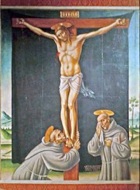
Crucifix (15th century)

Crucifixion (15th and 16th centuries)

-
✴the wooden crucifix (15th century), which is attributed to Giovanni Tedesco; and
-
✴the frescoed backdrop (16th century), which is attributed to Giovanni di Pietro, lo Spagna. This depicts the Virgin and SS Mary Magdalene, Francis and John the Evangelist.
Madonna and Child with saints and angels (16th century)
This altarpiece is attributed to Domenico Alfani. It depicts the Madonna and Child with SS Antony of Padua and Louis of Toulouse. Two angels hold a crown over the head of the Madonna, and the donor kneels to the left. (It was not on display when I visited the Pinacoteca in June 2009).
Nativity (16th century)
Deposition (16th century)

Martyrdom of Gorcum (after 1675)

This panel is a copy of one of the prints depicting the scene (as yet unpublished) that were circulated after the beatification. The Nicoletti family, whose arms appear at the lower left of the panel, probably commissioned it. A member of this family, Gabriele Nicoletti, wrote a book (1650) entitled “Supplimento delle guerre di Fiandra ” that described later hostilities in Holland (in 1623-1625): it seems likely that the beatification in 1675 of these martyrs from earlier hostilities prompted his family to commission the panel in his memory.
(The same subject is depicted in a panel in Santa Maria dell’ Oro).
[I am grateful to Dr. Roy Tepe for sending me much of this information.]
